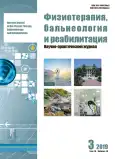Эффективность комбинированного применения RF-терапии и лазерных технологий в коррекции инволютивных изменений кожи лица
- Авторы: Кручинская М.Г.1, Мантурова Н.Е.2, Стенько А.Г.1
-
Учреждения:
- АО «Институт пластической хирургии и косметологии»
- ГБОУ ВПО «Российский национальный исследовательский медицинский университет им. Н.И. Пирогова» Минздрава России
- Выпуск: Том 18, № 3 (2019)
- Страницы: 145-153
- Раздел: Оригинальные исследования
- URL: https://journals.rcsi.science/1681-3456/article/view/62571
- DOI: https://doi.org/10.17816/1681-3456-2019-18-3-145-153
- ID: 62571
Цитировать
Полный текст
Аннотация
Биполярные радиочастотные устройства имеют все теоретические предпосылки для использования в комбинации, с фототехнологиями, при этом проявляются свойства электрооптической синергии.
Материал и методы. В исследование были включены 125 пациентов в возрасте от 40 до 50 лет. В зависимости от терапии пациенты были распределены на 4 группы и подгруппы А и В в зависимости от выявленных предикторов эффективности лазерной терапии.
Результаты исследования. После применения комбинированных методов отмечалось более значимое улучшение качественных характеристик кожи: повышение увлажненности кожи в группе 1А показатель корнеометрии увеличился на 24,6%, в группе 1В — на 28,3%, в группе 2А — на 38,9%, в группе 2В — на 37,3%, в группе 3А — на 29,1%, в группе 3В — на 27,5%, в группе 4А — на 38,8%, в группе 4В — на 38,8%; повышение эластичности кожи в группе 1А показатель Ua/Uf увеличился на 13,2%, в группе 1В — на 13,9%, в группе 2А — на 27,9%, в группе 2В — на 29,0%, в группе 3А — на 14,9%, в группе 3В — на 14,6%, в группе 4А — на 28,2%, в группе 4В — на 28,2%, что сопровождалось более выраженным уменьшением выраженности морщин по данным профилометрии. Применение лазерной терапии (эрбиевый или неодимовый лазер) и микроигольчатой RF-терапии способствует более значимому восстановлению эпидермально-дермальной структуры кожи, что подтверждается данными ультразвукового исследования: микрорельеф улучшился по сравнению с монотерапией более чем в 3 раза, толщина дермы — в 2,2 раза и акустическая плотность — в 1,7 раза.
Вывод. Комбинированные методы в большей степени, чем монолазерная терапия способствуют повышению качества жизни пациентов по данным динамики индекса визуальной шкалы качества жизни, который снизился в группах 1 и 3 в среднем на 47,1% и 44,4% против 57,8% и 64,3% в группах 2 и 4, при этом отмечалась достоверная разница в значениях индекса визуальной шкалы качества жизни в группах А и В (р < 0,01). В соответствии с показателями шкал VAS и GAIS оптимальный эффект после курса терапии с сохранением результатов через 1 год был достигнут у 25/12,5% пациентов в группе 1А, у 46,7/33,3% в 1В группе, у 43,7/37,5% пациентов 2А группы, у 78,6/71,4% пациентов группы 2В, у 33,3/20,0% пациентов группы 3А, у 50,0/25% пациентов группы 3В, 58,8/58,8% и 75,0/75,0% у пациентов групп 4А и 4В соответственно, что свидетельствует о высокой эффективности комбинированных методов и стойкости полученных результатов.
Полный текст
Открыть статью на сайте журналаОб авторах
Марина Генриховна Кручинская
АО «Институт пластической хирургии и косметологии»
Автор, ответственный за переписку.
Email: iphk@iphk.ru
к.м.н.
Россия, МоскваНаталья Евгеньевна Мантурова
ГБОУ ВПО «Российский национальный исследовательский медицинский университет им. Н.И. Пирогова» Минздрава России
Email: iphk@iphk.ru
SPIN-код: 5232-0412
д.м.н.
Россия, МоскваАнна Германовна Стенько
АО «Институт пластической хирургии и косметологии»
Email: iphk@iphk.ru
Scopus Author ID: 562467
д.м.н.
Россия, МоскваСписок литературы
- Коновка Е.П. Применение комбинированных лазерных воздействий в восстановительной коррекции инволютивных изменений кожи лица. Дис. … д-ра мед. наук. М.; 2014. 236с.
- Юсупова Л.А. Объемное моделирование с помощью комбинированных филлеров на основе гиалуроновой кислоты и декстраномера. Инъекционные методы в косметологии. 2016;4:17–19.
- Иванова Е.В. Патогенетическое обоснование применения кислородно-озоновой смеси в коррекции возрастных изменений кожи. Автореф. дисс. … канд. мед. наук. М., 2007. 23 с.
- Pritzker R.N., Hamilton H.K., Dover J.S. Comparison of different technologies for noninvasive skin tightening. J Cosmet Dermatol. 2014;13:315–23. doi: 10.1111/jocd.12114.
- Жукова О.В., Круглова Л.С., Фриго Н.В. Способ эстетической коррекции инволютивных изменений кожи лица. Клиническая дерматология и венерология. 2018;17(2):114-117.
- Vachiramon V., Sirithanabadeekul P., Sahawatwong S. Low-fluence Q-switched Nd: YAG 1064-nm laser and intense pulsed light for the treatment of melasma. J Eur Acad Dermatol Venereol. 2015;29(7):1339-1346. doi: 10.1111/jdv.12854.
- Yun W.J., Moon H.R., Lee M.W., Choi J.H., Chang S.E. Combination treatment of low-fluence 1,064-nm Q-switched Nd: YAG laser with novel intense pulse light in Korean melasma patients: a prospective, randomized, controlled trial. Dermatol Surg. 2014;40(8):842-850. doi: 10.1097/DSS.0000000000000057.
- Chan C.S., Saedi N., Mickle C., Dover J.S. Combined treatment for facial rejuvenation using an optimized pulsed light source followed by a fractional non-ablative laser. Lasers Surg Med. 2013;45(7):405-409. doi: 10.1002/lsm.22162.
- Atiyeh B.S., Dibo S.A. Nonsurgical nonablative treatment ofaging skin: radiofrequency technologies between aggressive marketing and evidence-based efficacy. Aesth Plast Surg. 2009;33:283–94. doi: 10.1007/s00266-009-9361-9.
Дополнительные файлы









